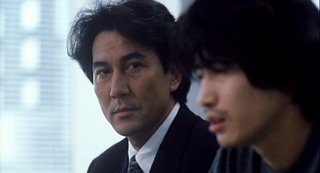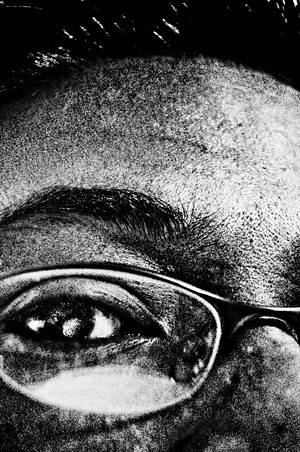
KYUA (english title: CURE)
Directed by: Kiyoshi Kurosawa
Screenplay: Kiyoshi Kurosawa (based on novel)
Copyright 1997
Cast: Koji Yakusho, Anna Nakagawa, Masato Hagiwara
With the release of Hideo Nakata’s Ringu (Ring, 1998) and its succeeding sequel here in the Philippines, viewers immediately lunged to grasp the cinematic ingenuity of Japanese directors in their near-convincing manipulation of the horror genre. Ring created the ambience of pure terror into the hearts of the viewing public—and unintentionally junked its Hollywood remake. Evidently, the advent of Japanese cinema among the Filipinos manifested a clear meaning: we are not cinematic morons as many perceived us to be.
Clearly, this statement is also indebted to Kiyoshi Kurosawa as the feature director for the month-long annual Eiga Sai Film Festival held at the Shangri-La Cinema, the CCP and the UP Film Center. Although it would only run for the entire March, the festival’s feature film is the psychological suspense thriller, KYUA (CURE). With this, Kurosawa was typed as a horror-auteur, succeeding Kyua with two more films of the same genre: Korei (Séance) and Kairo (Pulse). His name might be similar to the great filmmaker Akira Kurosawa who lifted the prevarication of the Japanese cinematic proficiency by bringing The Seven Samurais, Ran, Rashomon, The Hidden Fortress to global audience. It is in this sense that I surmise that the name Kurosawa is, if not, indirectly associated to the word Cinema, though there exists no sanguinary relation between the two.
Anyway, KYUA is admittedly, an intellectual horror. What lack visually is compensated by the screenplay itself. The plot revolves around a series of gruesome murders—its methods tangibly connected (leaving an X mark on different parts of the body), those apprehended were either the victims’ loved ones, colleagues or friends and although they admit being the ones who perpetrated the deed, their recollection of why they did it seemed to have lost in their consciousness. Enter police detective Takabe Ken-ichi (Koji Yakusho) who from the start of the investigation deftly surmised that a hypnotic trance carried the perpetrators into the grotesque reality of murder. Apparently, it turned out to be the work of an eccentric wanderer (Makoto Hagiwara)—whose real identity we wouldn’t know of until the latter part of the film. The arrival of this mysterious character challenged (but didn’t contest) Takabe’s claim of a possible hypnosis scenario, but rather attempted to see what behind the detective’s persona. The anticlimactic yet frightening denouement that reminded me of the conclusion of Twin Peaks is somewhat delicately interpreted though one could sense and notice the similarity between the two. Also, if one would notice the style Kurosawa adopted, it would be that of the prosaic touch mastered and perfected by the suspense meister Alfred Hitchcock.
If one would be asked on his/her reaction towards the film, they would probably claim that there are plenty of unnecessary scenes that needed adequate and thorough exposition. Kurosawa leaves such questions to the audience—for them to search for the answers and the explanations. Perhaps it is in this light that the movie deserves a second serving—a means of a visual laxative for the mental quench aggregated by a subtle psychological distress brought forth by an intensive miscomprehension of the film’s plot. Complicated though, but with the success of Ringu and its succeeding sequels on the Philippine moviegoing society, Cure could simply be an abrupt dose to the effects brought by Sadako.
Technically, Cure is a cinematic near-perfection: a delivery of an appropriate soundtrack that I could associate a Bernard Herrmann or an Ennio Morricone; Kurosawa’s screen shots made me reminisce of a “Babad” shot as explained by Filipino movie director Lore Reyes—which involves a mere panning of camera on a certain setting without any cuts and editing whatsoever. Kurosawa’s filmic reality, meanwhile lies according to the prosaic grounds of basic filmmaking, exuding the common processes of editing yet stylish in numerous instances (the “Babad” shot for example)—which often reminds me of Sergei Eisenstein in Battleship Potemkin or Robert Altman’s The Player.
While CURE may have lacked the Sadako-esque horror that most viewers would have probably anticipated, it delves deeply into the realms of the human psyche—the characterization of what is terrifying is subtly represented. Koji Yakusho’s portrayal of Takabe is similar to Kyle MacLachlan’s detective in David Lynch’s Twin Peaks. And from this point, I could also notice the poignant traits and the Lynch-esque perspective that Kurosawa may have adopted and skillfully modified. Makoto Hagiwara’s portrayal of the eccentric wanderer niftily put the mystery into the person responsible for the brutal deeds—and his incessantly-reiterated question of “Who are you?” added to the weight of mystery and terror into the development of both the storyline and the characters being groomed. Basically, as the film progresses into the climax and its gradual denouement, we are also treated to the same question repeatedly uttered by one of the characters. It is a query of our capability to understand the film better or are we just the same beings before and after we viewed the film. It is also a question that challenged our mental capacities into believing that it is only a movie—nothing more, nothing less—but somehow the situations presented justified the reality of something unfathomable. Hence, our existence as rational human beings is fundamentally what Kurosawa is trying to explain.
In the large spectrum of things, CURE tells of the vast possibilities the human psyche could (in some way) attain—whether it could lead to something sinister or not. It is a film that many people considered horror, but it tackles reality with twisted portrayals and mild exaggerations. Technically, Kurosawa’s camera works and cinematography made it extremely horrifying, nevertheless.
As a parting word, CURE is a manifestation of Kiyoshi Kurosawa’s brilliant vision and pen—and perhaps what we could refer to as the laxative that treated the recurring spells brought forth by Hideo Nakata and Sadako.

